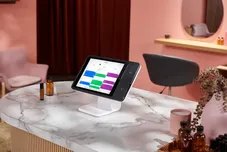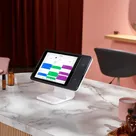Table of contents
As a business owner, you’re always looking for ways to streamline operations and improve the customer experience. If you run a busy restaurant or retail store, a self-service kiosk may help you do just that.
What is a self-service kiosk?
A self-service kiosk – also known as a self-service point of sale (POS) system – is an interactive touchscreen device that allows customers to buy products or services without staff assistance.
It includes hardware and software components that enable customers to browse items, place orders, and pay independently. Square Kiosk, for example, combines hardware, software, and payments into an all-in-one self-service ordering solution.
The hardware component of a self-service kiosk is a screen device mounted on surfaces such as walls, countertops, or floor stands. The software component is a kiosk application that allows you to design an ordering workflow tailored to your business.
How does a self-service kiosk work?
A self-service kiosk is an interactive terminal that allows customers to independently browse, customise, and complete transactions using a touchscreen interface. Powered by intuitive software, the self-service kiosk displays menus or options, responding to touch for seamless navigation. Customers can select items, adjust preferences (such as size or toppings) and proceed to payment through an integrated system, including a card reader, NFC (for mobile payments), or cash acceptor.
Once the self-service POS system confirms payment, the kiosk processes the order, often sending it to a backend system (like a kitchen or inventory database), and provides a digital or printed receipt. The benefits of self-service kiosks are plentiful, with the entire journey – from selection to completion – designed for speed, convenience, and minimal staff assistance, enhancing efficiency for both customers and businesses.
How to use a self-service kiosk
To use a self-service kiosk, a customer simply taps the touchscreen to begin and then follows the prompts to complete their task, whether it’s placing an order, checking out items, or accessing information. Common use cases for self-service kiosks include:
- Ordering food (customising meals, adding special requests)
- Self-checkout (scanning items, applying discounts, paying)
- Product lookup (checking prices, specs, or inventory)
- Ticketing and check-in (booking flights, printing boarding passes)
An array of industries use self-service kiosks, including:
- Restaurants (fast food, cafes, bakeries)
- Retail stores (supermarkets, clothing shops)
- Health and beauty (salons, fitness studios, spas)
- Transportation (airports, train stations)
- Entertainment (cinemas, galleries, museums)
- Healthcare (hospital check-ins, pharmacy pickups)
The process for using a self-service kiosk is quick, contactless, and user-friendly.
What are the benefits of a self-service kiosk?
Self-service kiosks can help businesses to:
Improve space management
A self-service kiosk can save a significant amount of counter space. Square Kiosk, for example, can be fixed on walls, counters, or floor stands, so you can customise the device to fit your space without making any major structural or layout changes to your restaurant or store. To guide the traffic flow towards your self-service kiosk, consider placing ‘Order here’ or ‘Self-service’ signage nearby.
Free up staff time
Customers can complete orders with minimal staff assistance on a self-service kiosk. This helps free up staff members for other important activities that benefit from human interaction.
For Joe La and Brian Taing, who own three Melbourne CBD hospitality businesses, including Sloppy Joe’s Deli and cafe-bakery Bloomwood, introducing Square Kiosks was about getting through big lines and rush periods by letting customers place their own takeaway orders. The change had an immediate impact on service levels and the placement of staff.
“Instantly, the second that it was set up, people were using it,” says La. “I hired more people in the kitchen instead of hiring an extra person to stand at the counter.
“On a revenue level, that person in the kitchen can end up making a lot more in value than someone standing at the counter,” he says.
According to the Square Future of Restaurants report, 75% of restaurant owners believe that AI and automation will improve key areas, such as inventory management, payments, and marketing. While more than 25% of diners reported preferring not to use any form of automation at restaurants, 74% of them indicated they want to see automation in at least one area to fill critical gaps when a restaurant isn’t fully staffed.
Embracing technology and onboarding a self-service kiosk may be particularly helpful if your business has a low headcount or, like many restaurants, is experiencing higher labour costs due to recent rising minimum wage requirements.
Give customers more control and a better customer experience
Self-service kiosks give customers greater privacy and control by allowing them to browse menus, customise orders, and pay without staff interaction, which is ideal for those who prefer a more independent dining experience or feel awkward making specific requests. Orders are processed instantly, reducing human errors and speeding up service, while built-in upselling features let customers explore add-ons at their own pace.
In self-service mode, customers have complete control over their orders, so they can select items they need quickly and check out faster. With no need to wait in line or rely on busy staff, transactions become faster and more convenient, leading to a smoother overall experience.
Increase your revenue while reducing costs
Adding a self-service kiosk to your restaurant or storefront can also help bring in more sales. First, self-service kiosks offer customers anonymity, so customers can order more items or make special requests without feeling judged.
Second, self-service kiosks allow you to set up well-planned upsells and other incentives that can be presented to customers in a carefully considered way. Many ordering platforms, like Square Kiosk, include visual menus with upselling features that suggest additional items based on a customer’s order. This can help drive up average spend by encouraging add-ons, such as sides and beverages, or calling attention to bundled meals.
Self-service kiosks play a big role in helping Brisbane-based PepperJack Sandwiches handle high order volumes. Co-owner Henry Wong says that the five Square Kiosks in store take a lot of pressure off the staff. “With the kiosk, there’s no line now,” he says. “Five or six people can order at the same time. It’s dramatically increased efficiency. It increased our max sandwich capacity at lunchtime by maybe 30%.”
With lower overheads and increased order accuracy, restaurants can see higher profit margins while enhancing the customer experience through convenience and faster transactions, meaning that the initial investment in self-service POS systems pays off through long-term savings and revenue growth.
Receive better customer insights
Customer activity on self-service kiosks is easily and accurately tracked, giving you more insight into customer behaviour and preferences by highlighting top-selling items and associated revenue. This data can enable you to hone your offer and create more targeted experiences.
For example, you might offer promos on the most popular menu items. Square Kiosk also integrates with Square Loyalty programs, so diners can easily enrol and accrue points with every order.
Self-service kiosk drawbacks
While self-service kiosks offer many benefits, it’s important to be mindful of potential challenges associated with them:
- Accessibility may be a concern for some customers who struggle with technology and touchscreens, necessitating staff assistance as a backup.
- Patron resistance from those who prefer traditional ordering, requiring clear instructions and transactional support. That’s why it’s important to have staff on hand to take orders for those who prefer face-to-face interaction.
With proper planning, including routine upkeep, inclusive design, and customer education (as well as support staff for those who prefer it), you can manage these hurdles effectively.
How much does a self-service kiosk cost?
The cost of self-serve kiosks for restaurants can vary widely based on features, hardware quality, and software complexity. Basic models, which can cost several hundred dollars or more each, cover the essentials and serve as an affordable entry point to introducing self-service kiosks. Advanced systems with features such as large touchscreens, integrated payment processing, and custom branding can cost considerably more, a couple of thousand dollars, per unit.
Additional expenses may include installation, maintenance, and software licensing fees. However, many businesses see a strong return on investment through labour savings and increased sales, making self-service kiosks a cost-effective upgrade over time. Leasing options and subscription-based software can also help reduce upfront costs.
How to set up a self-service kiosk for your business
Analyse your business needs
Consider whether a self-service kiosk is a wise investment for your business. Think about the purpose of your kiosk and how you intend to use it. For example, if you run a busy quick-service restaurant, you may want to speed up customer service or optimise space. In contrast, if you operate a full-service restaurant, you may need an easy way for servers to punch in orders without crowding the kitchen or counters.
Choose the right device
Once you’re clear about the purpose of your self-service kiosk, the next step is to choose a device. Consider ease of use. The last thing you want is a device that’s difficult for customers to use or requires several minutes of explanation from a staff member. That defeats the purpose and experience of a self-service kiosk.
The same goes for your staff. Choosing a solution that integrates directly with your POS, such as Square for Restaurants, and kitchen display system, like Square KDS, can help your team fulfil more orders quickly.
Next, match device specs against your requirements. If freeing up counter space is a key requirement, a compact device, such as Square Kiosk, which can be fixed anywhere – on a wall, a flat surface, or a floor stand. A compact design can also give you space to add more than one self-service kiosk to your store or restaurant to take even more orders.
Set up your self-service kiosk
Choose a suitable spot in your store or restaurant. Depending on the device you choose, you may not need a technician to install it. For example, all the mounting hardware needed to install Square Kiosk is included in the box, requiring zero service visits. Plus, if you change your mind about a kiosk location, you can simply uninstall it and move it to another location.
While physically installing a self-service kiosk takes about an hour, the whole project, from planning and prototyping to full deployment, can take several months for large, custom solutions. The timeline depends on factors like scope, vendor selection, and whether the self-serve kiosk you choose is off-the-shelf or custom-built.
Promote your self-service kiosk
Your self-service kiosk is only helpful if your customers use it. Inform customers about your kiosk and find ways to boost adoption. In-store signage can introduce customers to the kiosk and provide easy instructions. You can also encourage customers to use it by offering a discount on orders placed via the self-service kiosk.
Self-service kiosk FAQs
Are self-service kiosks replacing workers?
Self-service kiosks are not intended to eliminate jobs, but rather to shift staff attention toward higher-value, customer-focused tasks. In essence, self-service POS systems can offer employees an array of benefits:
- Repetitive task management, including order-taking and payments, so that staff can shift to higher-value roles like customer service, food prep, and table maintenance.
- More engaging work for employees, such as resolving issues, upselling in person, and ensuring a smoother dining experience.
- Labour optimisation to help manage peak hours.
- Reduced manual entry, so teams can focus on speed and quality, reducing stress and errors during rushes.
Why would people use self-service kiosks?
The 2025 Square Future of Restaurants report found that 68% of consumers at a restaurant, retailer, beauty salon, or spa prefer using self-service checkouts. Self-serve kiosks offer customers convenience, speed, and control. Many customers will use kiosks because they make ordering faster, reduce wait times, and often provide a more personalised or private experience.
![]()













